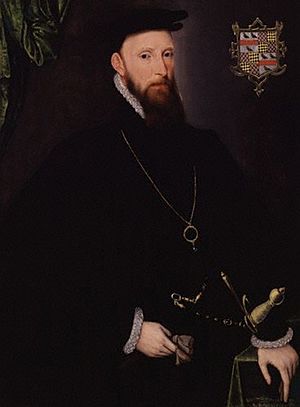John Lumley, 1st Baron Lumley facts for kids
Quick facts for kids
John Lumley
|
|
|---|---|
| 1st Baron Lumley | |
 |
|
| Born | c. 1533 |
| Died | 11 April 1609 (aged c. 76) |
John Lumley, 1st Baron Lumley (born around 1533, died 1609), was an important English noble. He is best known for being one of the greatest collectors of art and books during his time. He was also made a Knight of the Bath.
Contents
John Lumley's Early Life
John Lumley was born around 1533. He was the grandson of another important person, also named John, Lord Lumley. John's father, George Lumley, had faced trouble and was executed before his own father died. This meant John couldn't automatically inherit his grandfather's noble title.
When John was a child, his grandfather passed away in 1544. John asked King Edward VI for help. In 1547, a special law was passed by Parliament. This law made sure that John Lumley and his male descendants could use the title "Baron Lumley." So, he became the 1st Baron Lumley. He was called to join Parliament from 1553 until 1605.
On November 29, 1553, he became a Knight of the Bath. He attended the crowning ceremony of Queen Mary I. He also helped with the coronations of Queen Elizabeth I and King James I.
John Lumley was sometimes suspected of being involved in secret plans with Mary, Queen of Scots. Because of this, he was put in prison in 1570. Later, in 1586, he was one of the judges at the trial of Mary, Queen of Scots. He also served as a judge in another important trial in 1602.
John Lumley's Marriages
Lord Lumley married his first wife, Jane, before the end of 1550. Jane was the daughter of Henry Fitzalan, Earl of Arundel. Jane was one of the important ladies at Queen Mary I's coronation in 1553. She passed away in 1577 and was buried in Cheam, Surrey. Three of their children also died when they were very young and were buried there too.
Later, Lumley married his second wife, Elizabeth Darcy. Elizabeth lived 10 years longer than her husband. She was buried in Cheam in 1617.
Nonsuch Palace and Lumley's Collections
Lumley's main family home was Lumley Castle in County Durham. However, he also became the owner of Nonsuch Palace in 1580. This happened because his first wife's father, the Earl of Arundel, had bought the palace from Queen Mary in 1556.
While living at Nonsuch, Lord Lumley created a beautiful and large garden. In 1592, he gave Nonsuch Palace back to Queen Elizabeth. This meant it became a royal palace again after 36 years. When the palace returned to the Queen, a detailed list of all of Lumley's belongings there was made. Lumley continued to live at Nonsuch as the Keeper of the Palace.
When he passed away in 1609, he left his amazing library of books to Henry Stuart. Henry was the oldest son of King James I. This collection became a very important part of the Old Royal Library, which later grew into the famous British Library.
Lumleian Lectures
Lord Lumley, along with a person named Richard Caldwell, started a series of lectures in 1582. These lectures are called the Lumleian Lectures, and they are still given today!
At first, these lectures were about anatomy (the study of the body) and surgery. Their goal was to share knowledge and help people in England learn more about how the human body works. Today, the lectures are about general medicine.
Originally, there were plans for weekly lectures to cover a full anatomy course. By 1616, they were given three times a year. It was during a Lumleian Lecture in 1616 that William Harvey first announced his discovery of how blood circulates in the body.
Today, the lecture is given once a year by the Royal College of Physicians of London.
Death and Legacy
John Lumley passed away on April 11, 1609, when he was 76 years old. He did not have any children who lived to adulthood. When he died, the title of Baron Lumley (which was created in 1547) ended. He was buried in Cheam with his first wife. There is a tomb and monument at St. Dunstan's Church that remembers Lumley and both of his wives.
A famous composer named John Bull wrote a beautiful piece of music in memory of Lord Lumley. In his will, Lumley left most of his property to his cousin, Richard Lumley, 1st Viscount Lumley.
See also
- Lumley inventories — lists of John Lumley's collections.

